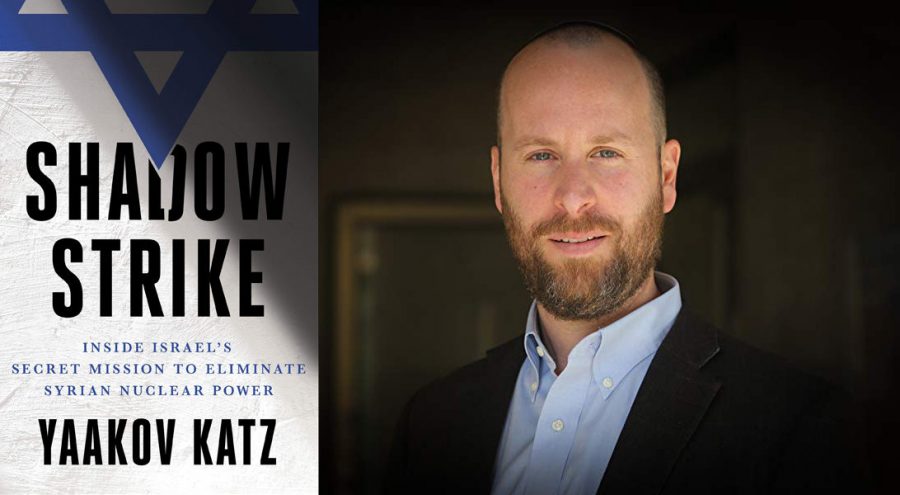Nail-biter ‘Shadow Strike’ details ultrasecret Israeli raid in Syria
Published July 25, 2019
The publication of “Shadow Strike” by Yaakov Katz, editor-in-chief of the Jerusalem Post, could not be more timely as he pulls back the layers of Israel’s daring and successful military and intelligence operations.
For example, on Sept. 6, 2007, just after midnight, Israeli fighter jets advanced on Deir ez-Zor in Syria, an event that might have been uneventful in view of the fact that Israel often flew over Syrian territory to warn its leaders to abide by the terms of the cease-fire after the Yom Kippur War of 1973.
The Israeli mission was one that ranks in the already legendary annals of the Jewish State’s audacious, mind-blowing intelligence and military operations. That includes a 1976 raid on Entebbe Airport in Uganda, which freed more than 100 hostages held by Palestinian and radical German terrorists. While the world slept, Israel carried out the courageous mission that inspired no fewer than four feature-length films.
The 2007 mission in Syria was to destroy a nuclear reactor built and supervised by North Korean operatives. The mission was carried out with precision and under the cloak of secrecy. Aerial photographs taken before the raid show a building that housed the nuclear plant. Photos taken after Israel’s attack that were published in The New York Times, Jerusalem Post and other news outlets worldwide showed an oblong crater where the plant once stood.
Israel, sensitive to the potential risk of Syrian President Bashar Assad Assad overreacting to “losing face” to the “Zionist entity,” did not confirm its responsibility for the attack.
The tiny Jewish State, which takes up territory the size of New Jersey, is the only nation among the nearly 200 on earth to have carried out successful attacks on Arab neighbors bent on its destruction.
In a white-knuckle chapter titled “Nuclear Deja Vu,” Katz details an incredible Israeli attack on Iraq’s nuclear plant in Osirik in January 1980.
That attack, like the more recent one in Syria in 2007, was also carried out with pinpoint accuracy and absolute fulfillment of its mission.
In 1990, Menachem Begin was prime minister of Israel; many members of his Polish Jewish family perished in the Holocaust. Iran was then ruled by iron-fisted “Butcher of Baghdad” Saddam Hussein. Begin did not want to miss an opportunity to prevent Hussein from developing nuclear weapons. Katz’s book describes a conversation between Col. Zev Raz, an Israeli air force squadron commander, and Maj. Amos Yadlin, who had just returned from flight training at Hill Air Force Base in northern Utah.
Raz told Yadlin: “We have been ordered to prepare for a long-range mission against a target far away. I need you to prepare the pilots.”
Yadlin, who was a member of a proud family of Israeli military leaders, did not hesitate to agree to coordinate the high-risk mission, which was carried out to perfection.
When former Israeli Prime Minster Ehud Barak was in St. Louis in 2016 for the St. Louis Speakers Series, he said that the mission against the Iraqi nuclear plant set back Iraq for as many as 15 years.
Had Saddam been allowed to go forward with his plans to develop nuclear weapons, he could have had a nuclear bomb by the time he invaded Kuwait, and Operation Desert Storm might never have occurred.
As bold and risky as the attack on the Iraqi plant was in 1990, the attack on the Syrian plant in 2007 targeted the interests of two nations: North Korea, which had detonated its first nuclear device the previous year; and Syria, which sought to develop them. Katz confirms that North Korean operatives were killed in the raid.
This chilling book also serves as a pipeline for conversations held among Israeli Prime Minister Ehud Olmert, U.S. Vice President Dick Cheney and other high level officials from both governments, conversations in the Oval Office, the prime minister’s office in Jerusalem and in the Israel Defense Forces’ storied underground war room beneath Tel Aviv.
The publication of “Shadow Strike” is eerily timely in view of escalating tensions between the United States and the Islamic Republic of Iran.
President Donald Trump pulled out of the Iran nuclear deal negotiated under his predecessor, Barack Obama, and then-Secretary of State John Kerry. Iran has confirmed that it has already breached the limits of uranium enrichment spelled out in the agreement, which was originally supported by the five permanent members of the United Nations Security Council plus Germany.
Israel, the United States and Iran have said they do not want to go to war over this volatile issue, but the danger of a miscalculation looms large. Will Israel strike for a third time to prevent an adversarial regime from developing nuclear weapons?
Katz discusses that possibility in a superb work of scholarship and gripping writing. “Shadow Strike” is a book that serious students of Middle East history and intelligence should keep close at hand during these turbulent times.















